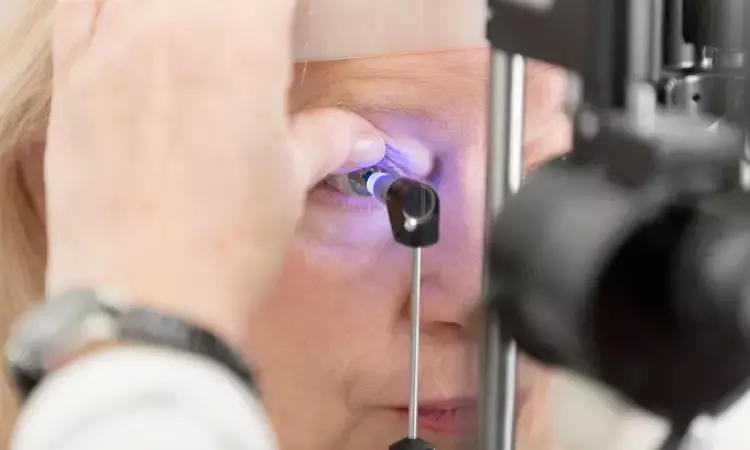- Home
- Medical news & Guidelines
- Anesthesiology
- Cardiology and CTVS
- Critical Care
- Dentistry
- Dermatology
- Diabetes and Endocrinology
- ENT
- Gastroenterology
- Medicine
- Nephrology
- Neurology
- Obstretics-Gynaecology
- Oncology
- Ophthalmology
- Orthopaedics
- Pediatrics-Neonatology
- Psychiatry
- Pulmonology
- Radiology
- Surgery
- Urology
- Laboratory Medicine
- Diet
- Nursing
- Paramedical
- Physiotherapy
- Health news
- Fact Check
- Bone Health Fact Check
- Brain Health Fact Check
- Cancer Related Fact Check
- Child Care Fact Check
- Dental and oral health fact check
- Diabetes and metabolic health fact check
- Diet and Nutrition Fact Check
- Eye and ENT Care Fact Check
- Fitness fact check
- Gut health fact check
- Heart health fact check
- Kidney health fact check
- Medical education fact check
- Men's health fact check
- Respiratory fact check
- Skin and hair care fact check
- Vaccine and Immunization fact check
- Women's health fact check
- AYUSH
- State News
- Andaman and Nicobar Islands
- Andhra Pradesh
- Arunachal Pradesh
- Assam
- Bihar
- Chandigarh
- Chattisgarh
- Dadra and Nagar Haveli
- Daman and Diu
- Delhi
- Goa
- Gujarat
- Haryana
- Himachal Pradesh
- Jammu & Kashmir
- Jharkhand
- Karnataka
- Kerala
- Ladakh
- Lakshadweep
- Madhya Pradesh
- Maharashtra
- Manipur
- Meghalaya
- Mizoram
- Nagaland
- Odisha
- Puducherry
- Punjab
- Rajasthan
- Sikkim
- Tamil Nadu
- Telangana
- Tripura
- Uttar Pradesh
- Uttrakhand
- West Bengal
- Medical Education
- Industry
Calcium channel blockers tied to glaucoma prevalence

Researchers have identified associations between calcium channel blockers or CCB use and the high prevalence of Glaucoma.
It is already known that Glaucoma is the leading cause of irreversible visual impairment. The only modifiable risk factor for glaucoma onset and progression is Elevated intraocular pressure (IOP).
The older age increases the frequency of comorbidities and polypharmacy. Glaucoma patients also have chronic systemic comorbidities like hypertension and diabetes mellitus (DM).
Researchers investigated the association of commonly used systemic medications with Glaucoma and IOP (European population). The study design was a Meta-analysis of eleven population-based cohort studies of the European Eye Epidemiology (E3) consortium, including 143240 participants and 47177 participants in Glaucoma and IOP analyses, respectively. The main outcomes measured in the study were Glaucoma prevalence and IOP.
They examined associations of four categories of systemic medications (antihypertensive medications: beta-blockers, diuretics, CCBs, alpha-agonists, angiotensin-converting-enzyme inhibitors, angiotensin II receptor blockers; lipid-lowering medications; antidepressants; antidiabetic medications) with glaucoma prevalence and IOP. They also determined Associations with antidiabetic medications were examined in diabetic participants only.
The study results are:
- CCBs were tied to a higher prevalence of Glaucoma.
- There was a stronger association for the monotherapy of CCBs with direct cardiac effects.
- There was no clear association between antihypertensive medications, lipid-lowering medications, antidepressants or antidiabetic medications and Glaucoma.
- There was an association between systemic beta-blocker usage and lower IOP.
- Monotherapy of both selective and non-selective systemic beta-blockers was associated with lower IOP.
- They found an association between high-ceiling diuretics and lower IOP.
- There was no association between the Use of other antihypertensive medications, lipid-lowering medications, antidepressants, or antidiabetic medications and IOP.
They said, “Our study found a potentially harmful association between the use of CCBs and glaucoma prevalence.” The researchers also observed and quantified the association of lower IOP with systemic beta-blocker use.
The results of this study are helpful as glaucoma patients use systemic antihypertensive medications.
The study’s strengths are a large pooled sample size, identification of small effect associations, and good generalizability to European people.
Heterogeneity and cross-sectional design were some of the significant limitations of the study.
Further reading:
Vergroesen JE, Schuster AK, Stuart KV, Asefa NG, Cougnard-Grégoire A, Delcourt C, Schweitzer C, Barreto P, Coimbra R, Foster PJ, Luben RN, Pfeiffer N, Stingl JV, Kirsten T, Rauscher FG, Wirkner K, Jansonius NM, Arnould L, Creuzot-Garcher CP, Stricker BH, Keskini C, Topouzis F, Bertelsen G, Eggen AE, Bikbov MM, Jonas JB, Klaver CCW, Ramdas WD, Khawaja AP; European Eye Epidemiology (E3) Consortium. Association of systemic medication use with Glaucoma and intraocular pressure: the E3 Consortium. Ophthalmology. 2023 May 5:S0161-6420(23)00306-8. doi: 10.1016/j.ophtha.2023.05.001.
BDS, MDS in Periodontics and Implantology
Dr. Aditi Yadav is a BDS, MDS in Periodontics and Implantology. She has a clinical experience of 5 years as a laser dental surgeon. She also has a Diploma in clinical research and pharmacovigilance and is a Certified data scientist. She is currently working as a content developer in e-health services. Dr. Yadav has a keen interest in Medical Journalism and is actively involved in Medical Research writing.
Dr Kamal Kant Kohli-MBBS, DTCD- a chest specialist with more than 30 years of practice and a flair for writing clinical articles, Dr Kamal Kant Kohli joined Medical Dialogues as a Chief Editor of Medical News. Besides writing articles, as an editor, he proofreads and verifies all the medical content published on Medical Dialogues including those coming from journals, studies,medical conferences,guidelines etc. Email: drkohli@medicaldialogues.in. Contact no. 011-43720751


